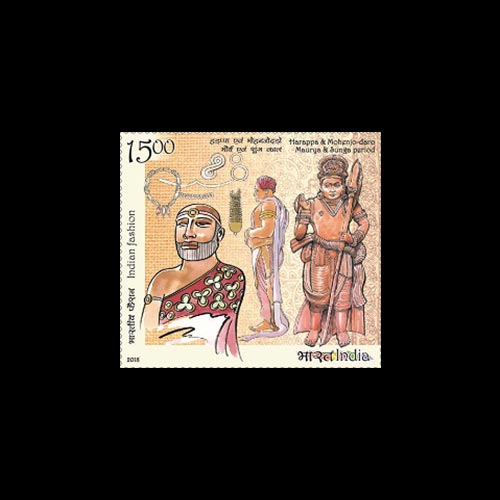Fascinating Archaeological Facts on Postage Stamps - 83
2025-08-08 Fri
Fashion and clothing have consistently been fundamental aspects of daily life across cultures. Notably, Indian textiles rank among the oldest in the world. According to Korisettar and Kunneriath, the Indian rock paintings from the Mesolithic era depict both men and women wearing garments secured around the waist, likely fashioned from leaves or animal Skin.The earliest evidence of clothing within the Indian subcontinent originates from the Harappan Civilization, where COTTON was cultivated and utilized as early as 2500 BCE. Multiple examples of preserved fibers have been discovered at archaeological sites such as Mohenjo-Daro and Harappa. Furthermore, the presence of spindles and spindle whorls at locations including Harappa, Mohenjo-Daro and Chanhudaro in present day Pakistan, Lothal (gujarat), Surkotada (Gujarat), and Kalibangan (Rajasthan) suggests that cotton spinning was a common Practice during this time.
Indirect evidence of early textile production is also observable through terracotta figurines and inscribed seals that illustrate various types of clothing, including skirts, shawls, and headgear. Notably, a statue of the Mother Goddess is depicted wearing an intricate headdress, a fitted Tunic, and a skirt secured with a broad waistband, along with two necklaces. For additional information on Harappan jewelry, please refer to This Post
Kenoyer in 'Ancient Textiles of the Indus Valley Region (2004)' claims that although cotton was the predominant fiber utilized within the Harappan Civilization, various forms of #wool and possibly jute or hemp was also employed.
The Evolution of fashion in India is further evidenced during the Mauryan and Shunga periods (321-72 BCE). In "Indica," Megasthenes provides observations regarding the social customs of the Mauryan period. A prevalent garment during this time was the antariya, worn as a lower garment. This piece resembled a lehenga-style cloth, forming a tubular skirt. A long cloth wrapped around the waist and pleated into the antariya was termed the patka, while the upper garment, known as the uttariya, took the form of a long scarf. The textiles used in this period were often dyed and printed, with methods for resist dyeing and hand printing documented in Indica.
Research by Guru et al., published in 2023, indicates that during the Shunga period, fabrics were predominantly made from cotton, silk, wool, Linen, and jute, which were commonly available. Luxurious fabrics crafted from high-quality fur, wool, and silk were reserved for the affluent members of society. The primary colors recognized for textile dyeing included red, white, yellow, and blue.
On 31 December 2018, India Post issued a set of 4 stamps and a Miniature Sheet celebrating the Heritage of Indian Fashion through the Ages. One of these stamps highlighted the fashion of the Harappan, Mauryan, and Shunga periods, with a face value of Rs 15.
Latest News
-
Ghiyath Shah as Heir Apparent
2025-09-25 ThuGhiyath Shah was the ruler of the Malwa Sultanate, reigning from 1456 to 1500. From 1456 to 1469, he...
-
Malwa Sultan Mahmud Shah Silver Coins
2025-09-11 ThuMalwa Sultan Mahmud Shah minted silver coins in round and square flans. <br><br> For round coins,...
-
Malwa Sultan Mahmud Shah Billon coin
2025-08-26 TueMalwa Sultan Mahmud Shah's billon coins followed three weight standards: 100 rati, 96 rati, and 80 r...
-
Fascinating Archaeological Facts on Postage Stamps - 91
2025-08-23 SatRhinoceros is one of the oldest land mammal species existing in India. There are five species of rhi...
-
Fascinating Archaeological Facts on Postage Stamps - 90
2025-08-23 SatUthiramerur, a Village in Kanchipuram, Tamil Nadu, is notable for its Temple inscriptions that descr...

